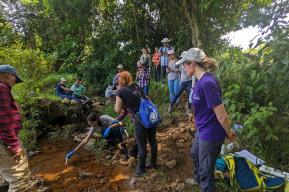Noticia
[Translate to espanol:] Earthquake and Tsunami in Chile: massive evacuation and building codes help to reduce loss of life

[Translate to espanol:] On 16 September 2015, an earthquake with a magnitude of 8.3 Mw occurred in the shallow depths near the coast of central Chile at 22:54 GMT, triggering the activation of the Pacific Tsunami Warning and Mitigation System. Timely alert messages allowed for the evacuation of nearly 1 million people in areas with high tsunami risk on the coast of Chile and Easter Island, according to the National Emergency Management Office of Chile (ONEMI). A tsunami spread across the Pacific, with waves up to 4.75 m hitting Coquimbo, Chile at 00:25 GMT. National authorities confirmed reports of 8 victims, mainly due to buildings collapsing during the earthquake, and coastal fringes of several cities were flooded. However, preliminary reports indicate that disaster preparedness and risk reduction strategies are bearing their fruits, as major casualties and damages were prevented.
[Translate to espanol:] While hazards are largely out of our control, disasters can be prevented through assessments, planning (including prevention, alert and response mechanisms) and education. In the case of Chile, local populations are well prepared; regional cooperation is effective; warning and response mechanisms are efficient. This requires constant efforts to develop, test and improve systems and to raise awareness.
Chile is actively involved in the UNESCO International Platform for Reducing Earthquake Disaster (IPRED) which is a platform for collaborative research, training and education in the field of seismology and earthquake engineering in order to reduce disasters due to earthquakes, especially on buildings and housing. Chile’s earthquake-resistant building standards provide a clear demonstration that risk can be contained even in highly seismic areas.
Chile’s National Tsunami Warning Center is under the responsibility of the Chilean Navy Hydrographic and Oceanographic Service (SHOA) and part of the Pacific Tsunami Warning and Mitigation System (ICG/PTWS), established in 1965 by UNESCO’s Intergovernmental Oceanographic Commission to facilitate the speedy dissemination of alerts across the region and to support countries’ ability to respond to and mitigate tsunamis locally. UNESCO has done significant work on education for tsunami preparedness globally through its offices in Santiago, Lima and Quito, together with its Intergovernmental Oceanographic Commission (IOC-UNESCO), focusing on the countries of South America’s Pacific Coast.
As of 1 October 2014, the Pacific Tsunami Warning Center (PTWC) is delivering enhanced tsunami information products to improve countries’ response capability and provide advanced notice of potential local tsunamis while reducing the numbers of areas warned (and potentially evacuated) unnecessarily.
The tsunami alert has been lifted in Chile, but national tsunami warning centers caution that sea level changes and strong currents may yet occur along some coasts; these could be a hazard to swimmers and boaters as well as to persons near the shore in some areas of South West Pacific region and Hawaii.
Related links:
- Disaster risk reduction
- Earthquake preparedness
- Tsunami preparedness
- IOC-UNESCO Tsunami Programme
- Pacific Tsunami Warning and Mitigation System (ICG/PTWS)
- Strengthening of the Regional Tsunami Early Warning System: preparations in Chile, Colombia, Ecuador and Perú (DIPECHO VII project)
- Teacher modules: Gestión del Riesgo de Tsunamis en Establecimientos Educacionales: Material de Apoyo para Docentes de Educación Básica, Media y Parvularia
- Gestión del riesgo de tsunamis en establecimientos educacionales - Parvulario
- Gestión del riesgo de tsunamis en establecimientos educacionales - Básica
- Gestión del riesgo de tsunamis en establecimientos educacionales – Media - Pacific Tsunami Warning System, A Half-Century of Protecting the Pacific, 1965-2015 (pdf)
- Tsunami Warning! (video)








